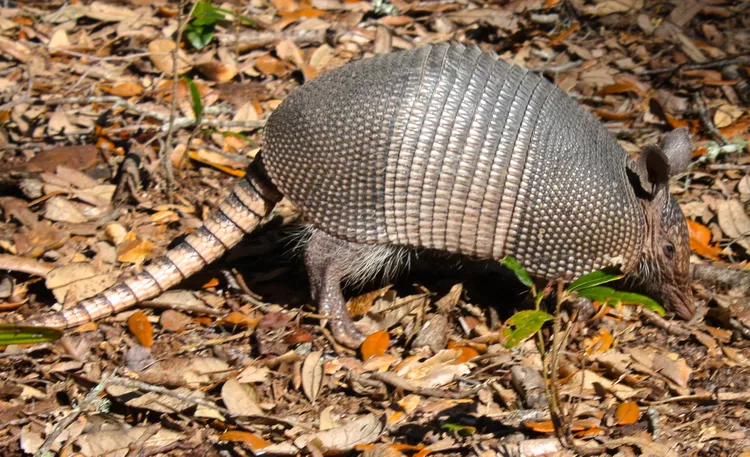Did you know that the word armadillo comes from Spanish and means “little armored one”? These unique creatures wear natural armor made up of bony plates covered in keratin — the same material found in human nails and hair. With around 20 different species, armadillos vary widely in size, behavior, and habitat, and all trace their roots back to South America.
From their surprising swimming skills to their unusual reproductive quirks, here are 13 curious facts that might just change the way you see these remarkable animals.
1. Only One Armadillo Species Lives in the U.S.

The nine-banded armadillo (Dasypus novemcinctus) is the only species to make its way into the United States. Originally limited to the humid subtropical South, its range has expanded northward — now reaching as far as Nebraska and Illinois — thanks in part to milder winters linked to climate change.
Interestingly, this species always gives birth to identical quadruplets, all originating from a single fertilized egg — a rare phenomenon among mammals. And if startled? They leap straight up in the air, sometimes 3–4 feet high!
2. The Brazilian Three-Banded Armadillo Came Back from “Extinction”
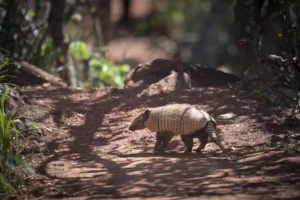
Once thought to be extinct, the Brazilian three-banded armadillo was rediscovered in 1988. Animals like this, once believed gone but later found alive, are known as Lazarus species.
Unfortunately, this armadillo is still in trouble. It’s listed as vulnerable by the IUCN and endangered in Brazil, mostly due to habitat loss from agriculture and poaching. Because it’s nocturnal and elusive, population numbers are hard to track.
3. Giant Glyptodonts Were Their Ancient Relatives

Armadillos have some prehistoric ancestors worth bragging about — meet the glyptodonts. These massive, tank-like mammals first appeared 35 million years ago and eventually grew to the size of a small car. Though they’ve long been extinct, scientists confirmed in 2016 that they were actually a subfamily of modern armadillos. Humans once hunted them for food and even used their tough shells as shelter.
4. Armadillos Sleep a Lot — Like, a Lot
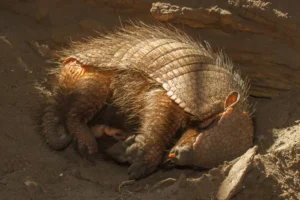
Being nocturnal, armadillos are most active at night, spending their time foraging, digging, and mating. During the day, they often sleep up to 16 hours, usually tucked away in cozy burrows.
Interestingly, while they usually prefer to live alone, their burrows are sometimes shared — not with other armadillos, but with tortoises, snakes, and rodents. Among mammals, only a couple of marsupials and ground squirrels spend more time foraging.
5. They Can Spread Leprosy to Humans
Believe it or not, armadillos are the only known nonhuman animals that can transmit leprosy, now called Hansen’s disease. Their naturally low body temperature allows the bacteria to thrive. Scientists believe armadillos first contracted the disease from European explorers in the 15th century. Today, humans may catch it through hunting, eating armadillo meat, or even inhaling contaminated dust from their feces.
6. Only Two Armadillo Species Can Roll into a Ball

While many people picture armadillos curling up into tight little balls, that’s only true for two species: the Brazilian and Southern three-banded armadillos, both in the Tolypeutes genus. The rest simply don’t have the flexibility — their segmented armor plates make it impossible.
7. The Giant Armadillo Is the Biggest of Them All

The aptly named giant armadillo (Priodontes maximus) is the largest living species. In the wild, they weigh anywhere from 45 to 130 pounds, and in captivity, some have reached up to 176 pounds. From nose to tail, they can stretch nearly six feet.
They also boast the longest claws of any mammal — their middle front claws can grow up to 8 inches long. Sadly, these giants are listed as vulnerable due to hunting, habitat loss, and illegal pet trade.
8. The Pink Fairy Armadillo Is the Smallest

On the other end of the spectrum, the pink fairy armadillo (Chlamyphorus truncatus) is the tiniest of the species. Measuring just 4 to 6 inches long and weighing around 3.5 ounces, it sports a distinctive pink shell and a flat tail used to help backfill its burrows.
Native to the sandy grasslands of central Argentina, it’s rarely seen. Though officially listed as data deficient by the IUCN, many experts believe it’s likely near threatened due to habitat destruction and increasing demand in the exotic pet market — where most die within days of captivity.
9. Some Armadillos Scream When Threatened

The screaming hairy armadillo (Chaetophractus vellerosus) lives up to its name. When frightened, it lets out loud, high-pitched screams as a defense mechanism. Despite being hunted for its meat and shell, it remains a species of least concern across much of its range in South America.
10. The Pichi Is the Only Armadillo That Hibernates
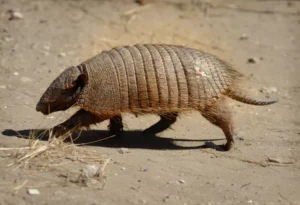
Most armadillos sleep a lot, but the pichi (Zaedyus pichiy) takes things a step further by hibernating each winter. It builds up fat reserves, burrows underground, and lowers its body temperature from 95°F to around 58°F. It also enters short, daily bouts of torpor throughout the year.
This species is native to the Patagonian Steppe and Pampas.
11. Several Species Are at Risk of Extinction
While some armadillo species, like the nine-banded, are thriving, others are struggling. The IUCN lists several species — including the Brazilian three-banded and the giant armadillo — as vulnerable. Others, such as the pichi and Southern long-nosed armadillo, are near threatened. Several more are data deficient, which likely means they’re in danger too.
Hunting and habitat destruction — particularly from agriculture, deforestation, and mining for copper — are the main drivers of their decline.
12. Their Shells Have Been Used to Make Instruments

Traditionally, Andean musicians crafted charangos — small 10-stringed instruments — using the shells of armadillos. Today, these instruments are more commonly made from wood or gourds due to animal protection laws.
In the past, their shells were also used to make noisy carnival rattles called matracas. Since 2015, it’s been illegal to buy or sell new armadillo matracas.
13. They’re Surprisingly Good Swimmers
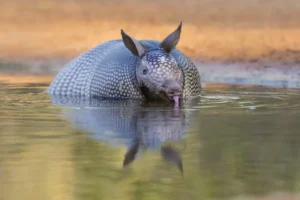
Despite their bulky appearance, armadillos are strong swimmers. They can hold their breath for 4 to 6 minutes and walk along stream bottoms. When crossing deeper water, they gulp air to make themselves buoyant and dog paddle across.
This swimming skill helped nine-banded armadillos cross the Rio Grande, contributing to their expansion across the U.S. in the 20th century.
